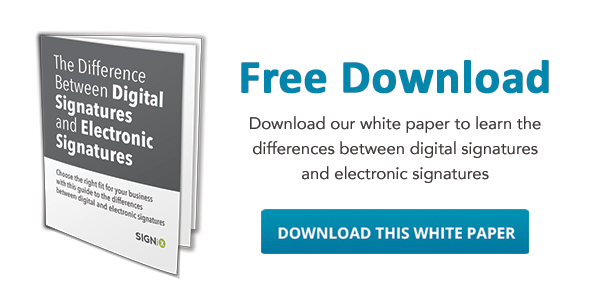 There's a lot of confusion about the difference between the terms "electronic signature" and "digital signature." In fact, many people use the phrases interchangably. Though they have a lot in common, there are some big differences between electronic and digital signatures. We’re here to help clear up some of the confusion.
There's a lot of confusion about the difference between the terms "electronic signature" and "digital signature." In fact, many people use the phrases interchangably. Though they have a lot in common, there are some big differences between electronic and digital signatures. We’re here to help clear up some of the confusion.
Simple Electronic Signatures
Simple electronic signatures are quite popular because they’re easy to use. Signers can sign documents online by simply typing their name or using their finger to sign a document on a tablet. Electronic signatures are:
-
Easy to use
-
Low cost
-
No hardware or software required
The problem with simple electronic signatures is that they’re not based on international standards. It’s up to each vendor to decide what level of security to provide, so you have to do a lot of research to find out whether a vendor’s technology is secure.
Simple electronic signatures are basically an image placed on top of a document. Anyone with simple photo or PDF editing software could change the document without any evidence of tampering.
Another problem with simple electronic signatures is something we call “vendor lock-in.” A lot of vendors require you to check back with them to find out if a signature is valid. That means that if you end your contract with the vendor, you could have to pay to have your documents verified.
Digital Signatures
A digital signature is a type of electronic signature that provides more security than a simple electronic signature. More countries around the world accept digital signatures because they comply with international security standards.
Digital signature technology uses special cryptography to prove that the document hasn’t been tampered with. Since the verification is embedded in the document, you don’t need to check back with a vendor to verify that the signature hasn’t been tampered with. That means you won’t be tied down to a single vendor for the life of your documents. Digital signatures are:
-
Based on standards
-
Tamper evident
-
Accepted internationally
SIGNiX Signatures
Can’t decide which type of signature is right for you? You don’t have to pick between electronic and digital signatures. SIGNiX’s digital signature offer the security of traditional digital signatures combined with the convenience of electronic signatures. SIGNiX’s digital signatures are:
-
Easy to use
-
Low cost
-
Cloud-based (no hardware or software required)
-
Tablet and mobile phone compatible
-
Based on standards
-
Tamper evident
-
Accepted internationally
Want to learn more about the difference between electronic signatures and digital signatures? Download your free digital copy of our white paper to learn more.
%20formatted-1.png?width=2528&height=739&name=SIGNiX%20Logo%20Main%20(white)%20formatted-1.png)


